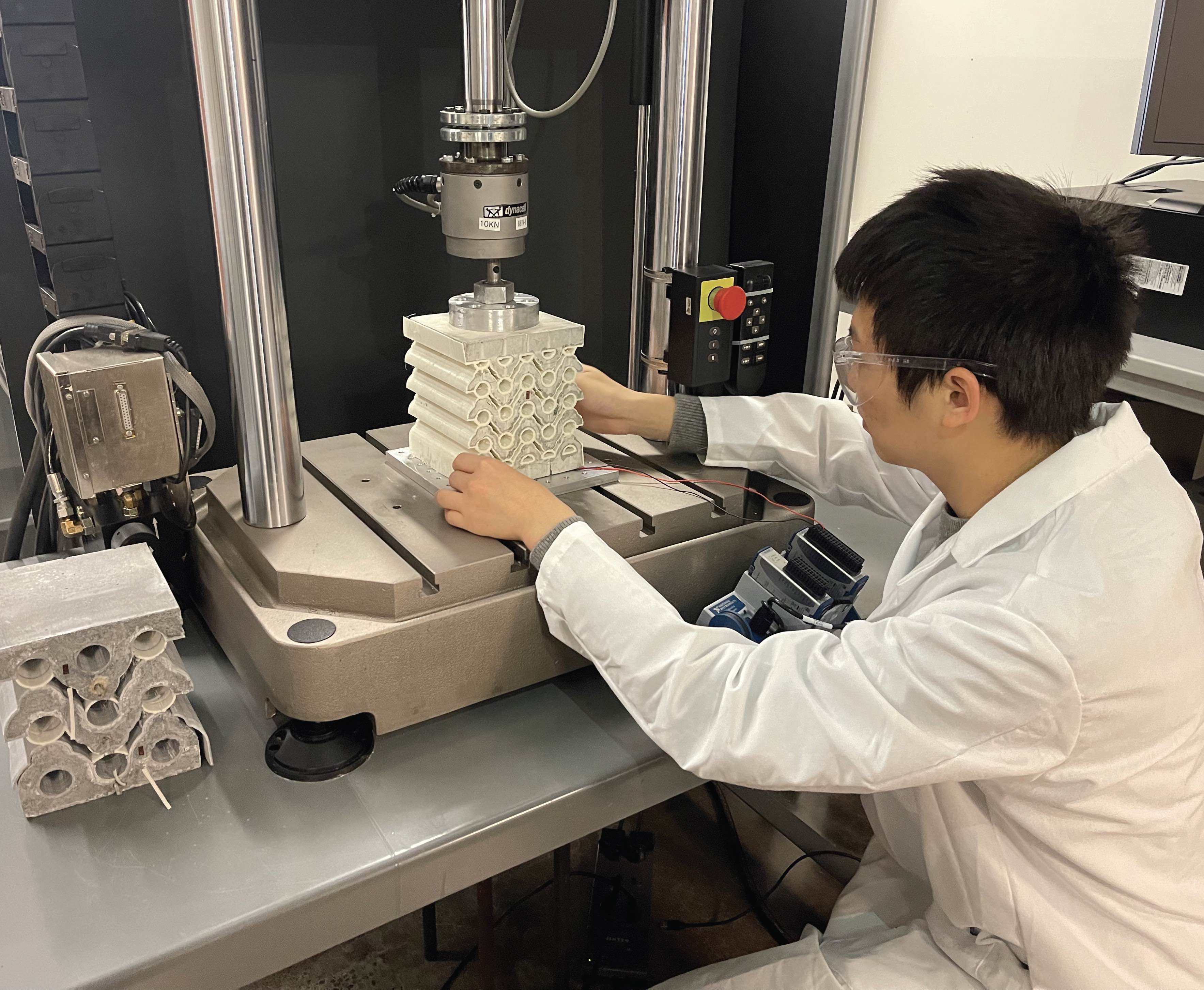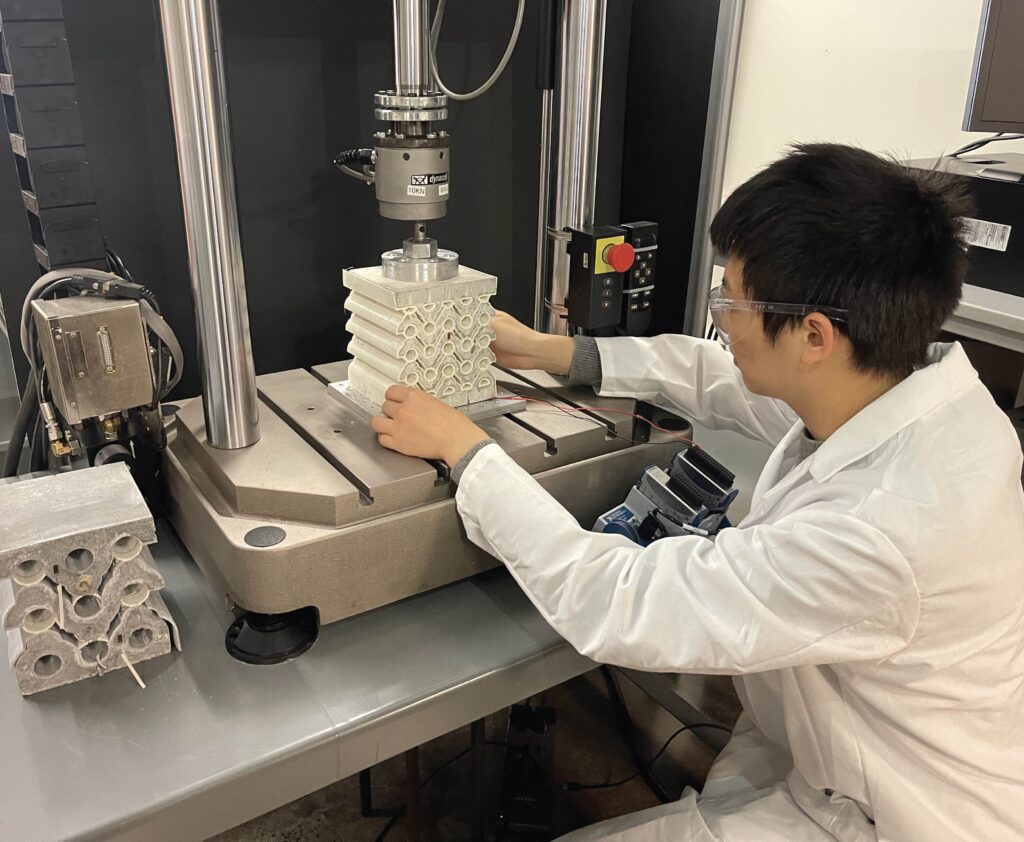Administration of the project
Intelligent concrete
• Metamaterials based on an auxetic polymeric lattice can be imbedded into a cement matrix to produce concrete with reduced brittleness and that demonstrates triboelectric properties.
• This concrete has been found to generate electricity upon mechanical excitation from stress that can be induced by an automobile passing over it on a highway.
• The voltage generated by this concrete changes due to structural damage giving it the ability to self-sense structural changes.
Concrete manufacture is an energy intensive process that dates back to the ancient Romans. Research has been ongoing to find approaches for reducing energy use and improving the sustainability of concrete. In a past TLT article,1 researchers used biomass left over from the processing of agricultural crops as a binder in the preparation of concrete. The biomass can be pretreated, burned in a combustion process to produce agricultural residue ash and used as a replacement for the main binder, tricalcium silicate. Agricultural residue ash used at a 20% replacement rate led to a 25% increase in compressive strength of the Portland cement.
Amir Alavi, assistant professor of civil and environmental engineering at the University of Pittsburgh in Pittsburgh, Pa., says, “Concrete is widely used in construction due to its compressive strength, easiness to shape and low cost to weight ratio. But concrete exhibits high brittleness, low tensile strength and low tensile strain capacities. Efforts have been made to use various types of reinforcements such as polymers in an effort to improve these characteristics.”
Alavi indicates that these poor properties also lead to the overuse of concrete during construction. He says, “Due to concern about safety, construction sites tend to use more than the necessary amount of concrete and reinforcement in specific applications to compensate for concern about strength and brittleness. This means that more construction material is produced than is necessary leading to higher energy use, higher costs and a lower degree of sustainability.”
Alavi and his colleagues recognize that there is an opportunity to develop a better performing concrete through introducing new functionalities. One option is the incorporation of a metamaterial-based design paradigm that can be used to improve and expand the use of concrete in a sustainable manner.
Alavi says, “Metamaterials are very specific artificial structures that gain their unprecedented mechanical properties through their rational geometric design rather than chemical composition. They have been evaluated for use in optics to produce cloaking materials and have been evaluated in electromagnetic antenna design. Currently, we are evaluating mechanical metamaterials in a new area, mechanical applications.”
Metamaterials have now been formulated into concrete to not only improve mechanical properties but also facilitate their use in sensing and energy harvesting.
Auxetic polymer lattices
The researchers developed metamaterials that are based on an auxetic polymeric lattice, which after imbedding in the cement matrix acts as a reinforcement. Alavi says, “The composite structure of the axial polymer within the cement matrix enables the resulting concrete to exhibit increased compressibility where it volumetrically contracts under an applied load and then completely recovers after the load is released. Mechanical properties of the cement are improved reducing brittleness. The auxetic polymer lattice from the metamaterial provides light weight reinforcement, and mechanical tunability.”
The auxetic polymer lattices are prepared from thermoplastic urethane and polylactic acid. Initially, the researchers prepared 3 x 3 and 5 x 5 unit cells by using a 3D printer (see Figure 1). These metamaterials are then mixed with a Type I/II Portland cement and water to form a cement paste that is cured for two weeks while submerged in water.

One interesting characteristic of the auxetic polymer lattices is their ability to demonstrate triboelectric properties within the composite concrete matrix. Alavi says, “We determined that the metamaterial-based concrete can act as a triboelectric nanogenerator upon mechanical excitation such as from stress placed by an automobile passing over it on a highway.”
Triboelectrification is induced due to the design of multiple layers of conductive concrete and two auxetic polymer layers. Concrete serves as the electrode, and the polymer components act as dielectric layers.
To enhance the generation of electricity, the researchers added 2% graphite to the mixture of Portland cement, auxetic polymer lattice and water. Alavi says, “Originally, we found that the concrete layers developed several cracks during initial testing. Despite the cracks, the material functionality and performance of the concrete was not affected. But we added the graphite as a conductive filler to reduce the initial cracking. The added benefit was to improve electrical power generation.”
Initial testing on a 3 x 3 metamaterial sample under displacement-controlled cyclic testing at 0.05 hertz showed a peak voltage of 14 volts for a displacement of 8 millimeters. The current measured was 236 nanoamperes, and the power generated was 330 microwatts.
Alavi says, “This experiment shows that the triboelectric nanogenerator-integrated concrete is suitable to act as a power force sensor without additional electronics. Additional research showed that voltage generated by the concrete changes due to structural damage. This occurs because the damaged concrete displays larger structural deformations due to decreasing stiffness. As a result, concrete produced with metamaterials has the potential to be self-sensing of structural damages.”
With this ability, nanogenerator-integrated metamaterials have the ability to be used in concrete to produce intelligent infrastructure systems. Alavi says, “One potential future application is for this intelligent concrete to communicate with electric vehicles (EVs) and autonomous vehicles (AVs). If higher power can be generated, it is feasible that intelligent concrete can be used to charge many electric devices on a highway.”
Additional information can be found in a recent article2 or by contacting Alavi at [email protected].
REFERENCES
1. Canter, N. (2013), “Concrete prepared from biofuel byproduct,” TLT, 69 (7), pp. 14-15. Available here.
2. Barri, K., Zhang, Q., Kline, J., Lu, W., Luo, J., Sun, Z., Taylor, B., Sachs, S., Khazanovich, L., Wang, Z. and Alavi, A. (2023), “Multifunctional nanogenerator-integrated metamaterial concrete systems for smart civil infrastructure,” Advanced Materials, 35 (14), 2211027.
Neil Canter heads his own consulting company, Chemical Solutions, in Willow Grove, Pa. Ideas for Tech Beat can be submitted to him at [email protected].

Be the first to comment